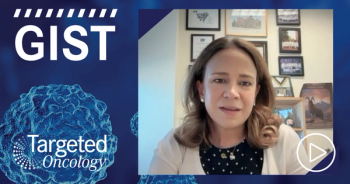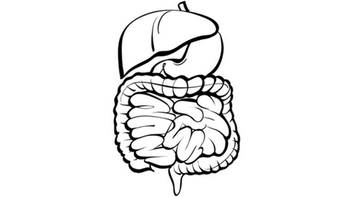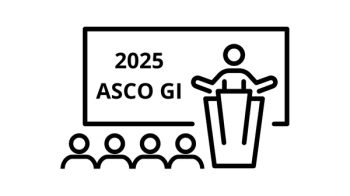
Case 1: INVICTUS Trial
The panelists discuss the phase 3 INVICTUS trial of ripretinib and the phase 1 study of ripretinib intra-patient dose escalation.
Episodes in this series

Mark Agulnik, MD: The data for the use of ripretinib comes from the phase 3 INVICTUS trial, which looked at 128 patients randomized in a 2:1 fashion to ripretinib at 150 mg once a day on a 28-day cycle vs placebo. Patients were kept on drug until disease progression by a blinded independent central review. At that point, they could escalate the dose to twice a day, they could continue once a day, or they could discontinue study treatment. For those patients on placebo, they could cross over to ripretinib at 150 mg once a day or they could discontinue the study treatment.
At disease progression for the group on placebo, if they went on to ripretinib at further disease progression, they could once again double the dose, stay on the same dose, or discontinue. The primary end point was progression-free survival. The other end points were overall response rate and overall survival.
What do people feel about the crossover—not the crossover per se, but being able to maintain on drug even if you have disease progression? I really liked it in this situation because we’ve already reached so many lines of therapy. I thought it was quite novel of them to do. Others’ thoughts not that?
Margaret von Mehren, MD: That is my standard of care for whatever drug they’re on. Certainly, people have looked at going back to older drugs, and there probably is some benefit—although not much—especially if somebody was smoldering, their disease was inching, creeping up. I had no concerns about staying at the same dose.
I thought it was nice to be able to increase the dose in the study just because in the phase 1 study we were trying to determine the maximum-tolerated dose. They didn’t come up with 1. The dose was selected based on the pharmacokinetics or the dose that they thought was required to inhibit the kinases. The higher dose is also very tolerable.
Richard Riedel, MD: I also like the study design. If nothing else, it mirrors what I was doing in practice with respect to imatinib. This particular trial design did answer 2 questions, both standard dose and the potential role for dose escalation upon progression. I liked it.
Mark Agulnik, MD: I liked it because I thought it resembled what we do in standard practice, and it didn’t restrict us. With respect to progression-free survival, as Meg alluded to earlier, placebo doesn’t do very much for our patients. Our patients do need to be on something.
When we look at what was essentially happening to patients, the majority of patients were deriving some stabilization of disease or improvement, but in the placebo arm, we see the majority are having their tumors grow. As we talked about the most common adverse events we’re going to see looking at grade 3 or 4, you do have about 11% with anemia, just shy of above 7% with abdominal pain, hypertension, and then a few will have nausea, fatigue, vomiting, and diarrhea at the grade 3 or 4 level.
We do know that ripretinib is included in our NCCN [National Comprehensive Cancer Network] Guidelines. It is as a fourth-line therapy for patients who have progressed on prior imatinib, sunitinib, or regorafenib or are intolerant to them. It is a category 1 preferred regimen.
There are also patient-reported outcomes that we could look at, and we see that patients on ripretinib tended to do better with respect to overall health and quality of life, as well as physical function and role function vs those on placebo whose measurements really deteriorated while on the placebo.
The patient has stable disease on ripretinib 150 mg once a day for 1 year, at which time the imaging showed further disease progression. We talked about it before and we highlighted in this study that what was nice was that we had the double dose of ripretinib. I guess that is the standard people would move to at this point.
Margaret von Mehren, MD: I would say in my practice, particularly having participated both in the phase 1 expansion, in the phase 3 study, and at this point the second-line therapy study that just completed accrual, I am comfortable with that. Patients tolerate it well, so I do that routinely.
Richard Riedel, MD: I do as well.
Mark Agulnik, MD: I do as well in my practice and certainly I don’t find—from the smaller numbers, Meg would have the higher numbers I would imagine, but none of us I would have that many concerns about the adverse events that we’re going to see at this double dose. It seems to be well managed.
The study looked at the phase 1 study of ripretinib intrapatient dosing. Here was an escalation and expansion with just patients who on disease progression and based on local review were offered to go on a double dose. There were 142 patients in the original trial and 67. This was presented just at CTOS [Connective Tissue Oncology Society] a few months ago.
Here we see that the progression-free survival for second-line patients was 11 months. When they went on the double dose, they got another 5.6 months. For third line, 8.3, and then you add an extra 3.3. For fourth line or beyond, it was 5.5 with the median progression-free survival on the 150 mg once a day. Then you get 4.6 more months with the double dosing. This is very encouraging, and this certainly shows value to why we would do that.
Once again, it’s once dosing vs twice dosing. You will have a little higher amount of patients getting a lipase increase, slightly higher amount of hypertension, diarrhea, hypokalemia, some dose interruptions, some dose reductions. You will get some treatment discontinuations related to the adverse events that you didn’t see with the single dose of ripretinib.
When we look at the updated progression-free survival curves, as well as the data for ripretinib vs placebo, we see that the median progression-free survival of ripretinib is 6.3 months. With placebo, it was 1 month. That was statistically significant. When we look at them at 6, 12, and 18 months, we see that 39.4% of patients had progression-free survival at 6 months, 14.6% at 12 months, and 6% at 18 months. The duration of response was 14.5 months for those with an overall response. About 11.8% of patients had a response rate.
Richard Riedel, MD: Mark, can I just ask: Do you think a placebo-controlled study is appropriate moving forward? We now have 3 studies with sunitinib, the GRID study with regorafenib, and now the ripretinib study. We show time and time again that time on placebo is short. I’m just wondering whether there is clinical equipoise in randomizing someone to placebo when we know they’re going to rapidly progress.
Mark Agulnik, MD: I wrestle with it, and that’s why I pause. I always wrestle with it. I think: What is in the best interest of these patients? One month progression. Because they’re rapidly progressing, one could argue that you’d get them on something pretty quickly afterward. Sometimes they even question some of the trials. If you’re moving them to phase 1, sometimes they need a washout period of 14 to 28 days. Here is your washout period right there, putting them on that placebo.
I put myself in the shoes of the patient, where you get desperate and you would take anything. A lot of them have preserved performance status. They could be younger patients and they’re looking for things. If it would end up giving me access to something, I would have no problems as a patient doing it. Is it my preference? No. But it doesn’t pose a barrier for me at this point because if they could switch over quickly, then at least I feel like this just acts as a washout period.
With respect to overall survival, the ripretinib arm has not been met yet, where the placebo was at 6.3 months. We see that 84% of patients on ripretinib were living beyond 6 months, 65% beyond a year, 53% beyond 18 months, and 50% at 24 months.
When we look at what was essentially happening to patients, the majority were deriving some stabilization of disease or improvement. But in the placebo arm we see the majority are having their tumors grow.
As we talked about the most common adverse events we’re going to see looking at grade 3 or 4, you do have about 11% with anemia, just shy of above 7% with abdominal pain, hypertension, and then a few will have nausea, fatigue, vomiting, and diarrhea at the grade 3 or 4 level.
We do know that ripretinib is included in our NCCN Guidelines. It is as a fourth-line therapy for patients who have progressed on prior imatinib, sunitinib, or regorafenib or who are intolerant to them. It is a category 1 preferred regimen.
There are also patient-reported outcomes that we could look at. We see that patients on ripretinib tended to do better with respect to overall health and quality of life, as well as physical function and role function vs those on placebo whose measurements really deteriorated while on the placebo.
The patient has stable disease on ripretinib 150 mg once a day for 1 year, at which time the imaging showed further disease progression. We talked about it before, and we highlighted in this study that what was nice was that we had the double dose of ripretinib.
Transcript edited for clarity.












































